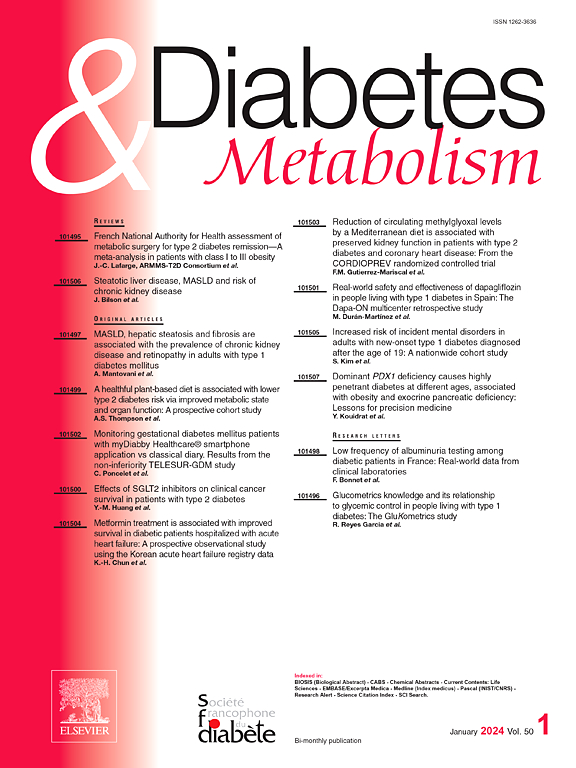Acute kidney injury is associated with liver-related events in patients with metabolic dysfunction-associated fatty liver disease
IF 4.7
2区 医学
Q1 ENDOCRINOLOGY & METABOLISM
引用次数: 0
Abstract
Background
Evidence regarding the role of acute kidney injury (AKI) in long-term development of metabolic dysfunction-associated fatty liver disease (MAFLD) is limited. We aimed to investigate the associations between AKI and liver-related events in patients with MAFLD.
Methods
This study involved 50,499 Chinese adults with MAFLD from the China Renal Data System (CRDS) database. We identified AKI using patient-level serum creatinine data according to the Kidney Disease Improving Global Outcomes (KDIGO) criteria. The primary outcome was a composite of liver-related mortality and major adverse liver outcomes. The secondary outcome was an escalation of fibrosis-4 (FIB-4) risk scores. Cox proportional hazard models were performed to assess the association between AKI and the study outcomes.
Results
The median age of the patients was 59.17 years, with 54.7% being male. There were 3,711 (7.3%) patients who experienced AKI during hospitalization. A total of 1,660 (3.3%) patients experienced composite liver outcome. Patients with AKI during hospitalization had higher risk of composite liver outcomes (adjusted hazard ratio (aHR) 1.83 [95% confidence interval 1.38;2.41] P < 0.001), especially among those with severe AKI (stage 2/3) (aHR 2.36 [1.57;3.54] P < 0.001). Regarding the secondary outcome, AKI was also associated with an increased risk of escalation of FIB-4 risk scores (aHR 1.28 [1.14;1.44] P < 0.001). These associations remained consistent across various subgroups and sensitivity analyses.
Conclusions
AKI was significantly associated with an increased risk of liver-related events among patients with MAFLD. These findings suggest that enhanced vigilance toward AKI may be justifiable in MAFLD patients.
代谢功能障碍相关脂肪肝患者的急性肾损伤与肝脏相关事件相关
背景:关于急性肾损伤(AKI)在代谢功能障碍相关脂肪肝(MAFLD)长期发展中的作用的证据有限。我们的目的是调查AKI与MAFLD患者肝脏相关事件之间的关系。方法:本研究纳入来自中国肾脏数据系统(CRDS)数据库的50499名中国成年MAFLD患者。我们根据肾病改善全球结局(KDIGO)标准,使用患者水平的血清肌酐数据确定AKI。主要结局是肝脏相关死亡率和主要不良肝脏结局的综合。次要结局是纤维化-4 (FIB-4)风险评分升高。采用Cox比例风险模型评估AKI与研究结果之间的关系。结果:患者中位年龄为59.17岁,男性占54.7%。3711例(7.3%)患者在住院期间发生AKI。共有1660例(3.3%)患者出现了复合肝脏结局。住院期间发生AKI的患者发生复合肝脏结局的风险较高(校正危险比(aHR) 1.83[95%可信区间1.38;2.41]P < 0.001),尤其是重度AKI(2/3期)患者(aHR 2.36 [1.57;3.54] P < 0.001)。至于次要结局,AKI也与FIB-4风险评分升高的风险增加相关(aHR 1.28 [1.14;1.44] P < 0.001)。这些关联在不同的亚组和敏感性分析中保持一致。结论:AKI与MAFLD患者肝脏相关事件风险增加显著相关。这些发现表明,在MAFLD患者中提高对AKI的警惕性可能是合理的。
本文章由计算机程序翻译,如有差异,请以英文原文为准。
求助全文
约1分钟内获得全文
求助全文
来源期刊

Diabetes & metabolism
医学-内分泌学与代谢
CiteScore
12.00
自引率
4.20%
发文量
86
审稿时长
13 days
期刊介绍:
A high quality scientific journal with an international readership
Official publication of the SFD, Diabetes & Metabolism, publishes high-quality papers by leading teams, forming a close link between hospital and research units. Diabetes & Metabolism is published in English language and is indexed in all major databases with its impact factor constantly progressing.
Diabetes & Metabolism contains original articles, short reports and comprehensive reviews.
 求助内容:
求助内容: 应助结果提醒方式:
应助结果提醒方式:


